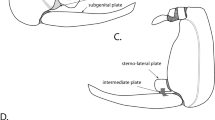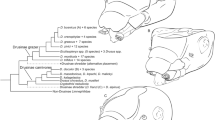Abstract
WHILE studying the structure of the pharynx and buccal cavity of some female Culicoides in an attempt to correlate their affinities, if any, with the taxonomy of the group, it was found that the structure varies considerably in both the local and exotic forms. In the case of Culicoides pulicaris, a European species, it is found that the pharyngeal armature is distinctly of Phlebotomus type,1 inasmuch as it not only bears distinct serrations posteriorly, but also is furnished along one of its walls with a thin, rather deeply chitinised, pigmented ridge, which in its turn carries a series of backwardly directed teeth (Fig. 1, a). The two local Indian species, namely, Culicoides oxystoma, Kieff., and C. peregrinus, Kieff., on the other hand, have pharyngeal armatures which apparently bear very little similarity with its related exotic form. The pharyngeal armature of these two forms is horseshoe shaped (Fig. 1, b), that is, the two arms are free at the proximal end, and they appear to be undivided at its distal region, leaving a very thin lumen in between, which communicates posteriorly with the alimentary canal. The two free ends simulate the open ends of the shells of a bivalve mollusc, and each bears a few filamentous, outwardly directed processes. The lateral fringes of the pharynx bear inwardly very fine serrations. The differences between the structures of the pharyngial armature of the two Indian species are as follows: In the case of C. oxystoma the lateral edges of the armature are somewhat more overlapping in the middle, and the lateral serrations are less distinct than, those of C. peregrinus.
This is a preview of subscription content, access via your institution
Access options
Subscribe to this journal
Receive 51 print issues and online access
$199.00 per year
only $3.90 per issue
Buy this article
- Purchase on Springer Link
- Instant access to full article PDF
Prices may be subject to local taxes which are calculated during checkout
Similar content being viewed by others
References
Adler, S., and Theodor, O., Bull. Ent. Res., 16, pp. 399–405; 1925–1926.
Author information
Authors and Affiliations
Rights and permissions
About this article
Cite this article
MUKERJI, S. Morphology of the Pharynx of Female Culicoides and its Taxonomic Importance. Nature 127, 339–340 (1931). https://doi.org/10.1038/127339b0
Issue Date:
DOI: https://doi.org/10.1038/127339b0
Comments
By submitting a comment you agree to abide by our Terms and Community Guidelines. If you find something abusive or that does not comply with our terms or guidelines please flag it as inappropriate.



